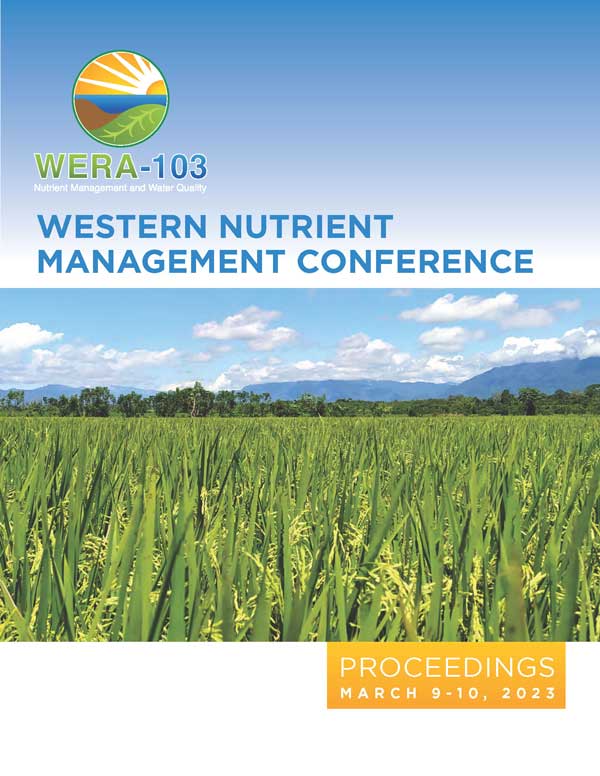Download the Conference Proceedings
Proceedings
Authors
| Filter results9 paper(s) found. |
|---|
1. Science and Stakeholder Engagement on 4R Nutrient Stewardship, Sustainability and Nutrient Performance Indicators: a Recent Central to Eastern U.S. and Global PerspectiveFarmers and society are becoming more aware of the need to better protect water, air and soil resources. The focus of the International Plant Nutrition Institute (IPNI) is on responsible nutrient management and stewardship to support the needs of the growing human family. Since 2007, IPNI has been more actively engaged with university scientists, federal and state agencies, agribusiness associations, crop advisers, and nongovernmental partners to get more of the applied nutrients - especially... C. Snyder |
2. Determining Lime Requirements for Idaho SoilsFor the past 25 years, northern Idaho soils have significantly shown a decline in soil pH, from pH 6.0 to around a pH of 5.6. Southern Idaho soils are mostly neutral to alkaline, with a pH of around 7.0 to 8.5, however, most agricultural soils pH is declining to pH < 4.5. Soil acidification is becoming a rising issue in soil sustainability, in which approximately 30% of the world surface is covered by acidic soils. Low soil solution pH can be induced by continued irrigation that increases... K.L. Mookodi, J. Spackman, J. Sagers, K. Schroeder |
3. Barley Yield and Protein Response to Nitrogen and Sulfur Rates and Application TimingThe introduction of new barley varieties, as well as changes in management practices, necessitate a re-evaluation of nitrogen (N) and sulfur (S) nutrient management guidelines. Nitrogen has a significant impact on barley grain quality and yield. Overapplication of N can result in lodging, groundwater pollution, and high protein content, resulting in lower end-use quality of barley, while underapplication of N results in reduced grain quality and yield. Sulfur promotes N utilization in barley plant... O. Adeyemi, J. Spackman, J. Sagers, J. Marshall, Z. Hong, R. Findlay, J. Bevan |
4. Optimizing Nitrogen Fertilizer Rates for Annual Cereal Forage ProductionNitrogen fertilizer provides one of the greatest returns on investment but also one of the highest operating expenses for annual cereal forage production. It is important to know the total nitrogen required by a crop to optimize yield and quality and to minimize nitrogen losses to the environment. It is also possible that annual cereal forage species and cultivars will have varying responses to nitrogen availability. The objective of this study was to determine the optimal nitrogen fertilizer... J. Spackman, R. Findlay, J. Sagers, J. Pandey |
5. Nitrogen Fertilizer Rate and Timing Implications for Malt, Food, and Feed Barley Production in Southern IdahoNitrogen is an essential nutrient required to produce high-yielding barley. Nitrogen strongly impacts barley yield, grain protein, tillering, and lodging potential. Unlike other crops such as corn, available nitrogen must be carefully managed for producers to achieve both optimal yield and grain quality for malt, food, and feed barley. Exessive nitrogen availability increases grain protein concentration that may be unsuitable for malting but may be ideal for feed or food barley. The objective... J. Spackman, O. Walsh, A. Adjesiwor, O. Adeyemi, J. Sagers, R. Findlay, J. Bevan |
6. What You Need to Know About the National Fertilizer Recommendation Team Called FRSTThe Fertilizer Recommendation Support Tool (FRST) team is a national effort to improve coordination of soil test recommendations in the United States. There are over 125 partners involved in FRST with representation of all four regional soil testing committees including WERA-103. The team has developed a national tool for P and K soil test calibrations (identifying critical soil test values for response to fertilizer), and are working on developing P and K calibration, tools for S calibration,... M. Yost, N. Slaton, J. Spargo, D. Kaiser, G. Buol, L. Gatiboni |
7. Non-dormant Alfalfa and Small Grain Rotations- Tillage and Fertility EffectsTo study the use of non-dormant and high nitrogen fixing alfalfa cultivars as a possible source of nitrogen for spring and fall-seeded wheat and barley grown under tilled and no-tilled conditions. Hi-Nitro, a non-dormant, high-nitrogen fixing alfalfa variety, and RoundUp Ready Stratica, a traditional dormant alfalfa cultivars were clear seeded in Aberdeen in 2023 and 2024. Forage was harvested 4 times. Fall or spring tillage was done approximately 3-14 days before planting fall or spring... R. Findlay, J. Spackman, J. Hatch, T. Jacobsen, J. Gibbons, J. Sagers, D. Callister |
8. Lime Incubation for Southern Idaho SoilsSoil acidity is a growing concern for agricultural productivity in Idaho, particularly in the eastern and northern regions where soils are trending acidic. Soil acidity below a pH 5.5 adversely affects the root development and nutrient uptake of crops like alfalfa, barley, and wheat. This study aims to determine the lime requirements for acidic soils in Idaho to optimize crop growth, specifically targeting pH levels of 5.5, 6.0, 6.5, and 7.0. Soil samples were collected from various grower fields... K. Young, J. Spackman, T. Jacobsen, J. Sagers, J. Hatch, R. Ritchie, J. Williams, K. Schroeder, A. Adjesiwor |
9. Liming for Improved Nutrient Utilization and Weed Management in WheatSoil acidification is an increasing concern for agricultural productivity in Eastern Idaho, where low soil pH threatens the yield and quality of key crops such as barley and spring wheat. Acidification occurs from the long-term application of ammonium-based fertilizers and other management practices, leading to aluminum toxicity and nutrient imbalances that inhibit root development and reduce yields. Farmers in the region are exploring strategies to address this challenge, including the use of... T. Jacobsen, J. Spackman, A. Adjesiwor, J. Sagers, K. Schroeder, J. Bevan, K. Mookodi, J. Gibbons |
